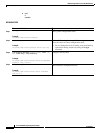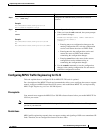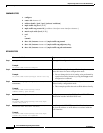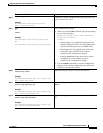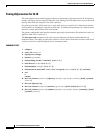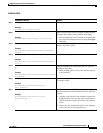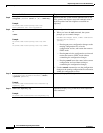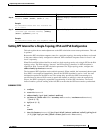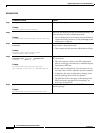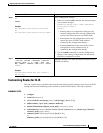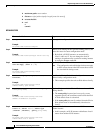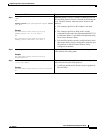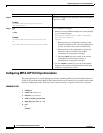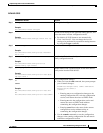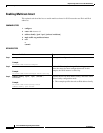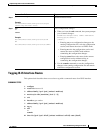
Implementing IS-IS on Cisco IOS XR Software
How to Implement IS-IS on Cisco IOS XR Software
RC-302
Cisco IOS XR Routing Configuration Guide
OL-14356-01
DETAILED STEPS
Command or Action Purpose
Step 1
configure
Example:
RP/0/RP0/CPU0:router# configure
Enters global configuration mode.
Step 2
router isis instance-id
Example:
RP/0/RP0/CPU0:router(config)# router isis isp
Enables IS-IS routing for the specified routing instance, and
places the router in router configuration mode.
• You can change the level of routing to be performed by
a particular routing instance by using the is-type router
configuration command.
Step 3
address-family {ipv4 | ipv6} [unicast |
multicast]
Example:
RP/0/RP0/CPU0:router(config-isis)#
address-family ipv6 unicast
Specifies the IPv4 or IPv6 address family, and enters router
address family configuration mode.
• This example specifies the unicast IPv6 address family.
Step 4
spf-interval {[initial-wait initial |
secondary-wait secondary | maximum-wait
maximum] ...} [level {1 | 2}]
Example:
RP/0/RP0/CPU0:router(config-isis-af)#
spf-interval initial-wait 10 maximum-wait 30
(Optional) Controls the minimum time between successive
SPF calculations.
• This value imposes a delay in the SPF computation
after an event trigger and enforces a minimum elapsed
time between SPF runs.
• If this value is configured too low, the router can lose
too many CPU resources when the network is unstable.
• Configuring the value too high delays changes in the
network topology that result in lost packets.
• The SPF interval does not apply to the running of the
ISPF because that algorithm runs immediately on
receiving a changed LSP.
Step 5
ispf [level {1 | 2}]
Example:
RP/0/RP0/CPU0:router(config-isis-af)# ispf
(Optional) Configures incremental IS-IS ISPF to calculate
network topology.



